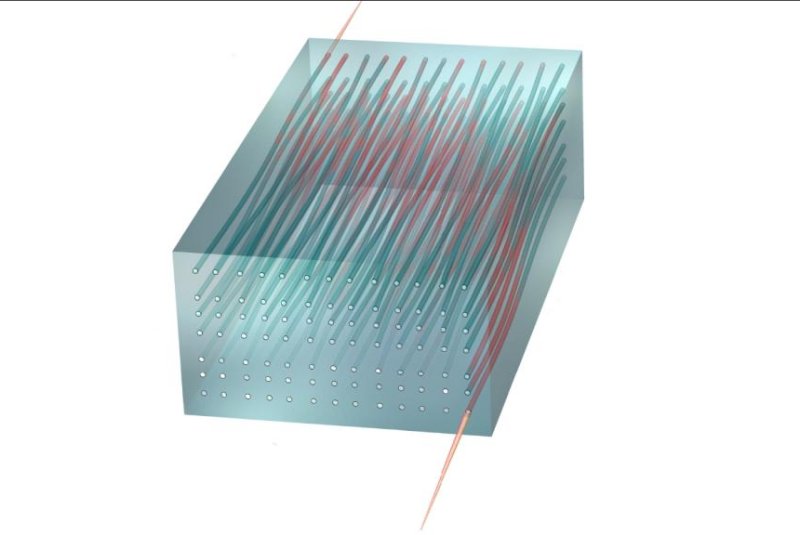A model shows the optical waveguide used by scientists to code the 4D quantum Hall effect. Photo by Rechtsman Laboratory/Penn State University
Jan. 29 (UPI) -- Two teams of scientists have measured the effects of a fourth dimension in a pair of lab experiments. Scientists didn't discover an extra dimension, but they did show how materials might behave if there was one.
"We don't have four spatial dimensions," researcher Mikael Rechtsman, a physicist at Penn State University, told UPI.
Physicists have been interested in the quantum Hall effect since it was first described in the 1980s. The effect described the fixed, quantized nature of conductivity in 2D materials.
"This was surprising to physicists because you have disorder in a material -- between different samples you expect to have different fluctuations," Rechtsman said.
When materials move from 2D to 3D, the quantum Hall effect disappears, but using advanced mathematics, physicists showed -- in theory -- how the effect would reappear in a hypothetical fourth dimension.
Until now, the hypothetical fourth dimension was only a math formula. Rechtsman and his colleagues translated the effect to the material world. They did so by emulating a 4D material with an array of wavelengths. To create the wavelengths, scientists etched tiny tubed patterns into a piece of glass using a laser. The system is known as a waveguide.
"We were able to kind of code in the third and fourth dimensions, almost like we were seeing a shadow of four dimensions," Rechtsman said.
Another team was able to replicate the effect by emulating extra-dimensional materials with laser-trapped atoms.
The experiments were described in two separate papers published this month in the journal Nature.
Researcher Oded Zilberberg, a physicist at ETH Zurich in Switzerland, worked on both experiments. He said keeping them separate in his mind wasn't a problem.
"Due to the fact that the experiments were studying complementary but not overlapping aspects of the model, it was not too difficult," Zilberberg said. "In the paper-writing phase, I was trying not to mix the narratives of the two papers, which was more challenging."
Both Rechtsman and Zilberberg said the two experiments and their results complement each other.
The experiment using laser-trapped atoms showed the effect in the center, or bulk, of the emulated material, while the experiment using the optical array replicated the effect on the material's edge.
"In topological phases of matter there is an important principle of bulk-edge correspondence and the idea of studying both aspects of our proposed model using these complementary techniques, systems, and teams was appealing to everyone involved," Zilberberg said.
The experiments were more than just theoretical exercises.
"Our work offers an elegant way of interpreting very complex materials, a type of material where the atoms are arranged in a very complex, inscrutable way," Rechtsman said.
By interpreting complex materials as derived by higher dimensions, researchers could use the techniques deployed by Rechtsman, Zilberberg and their colleagues to translate them into a simpler 2D rendering.
"We have seen for the first time that 4D topological effects can be seen in our world," Zilberberg said. "We have opened a porthole for studying other such types of higher-dimensional phenomena that we may encounter in our three-dimensional reality."















